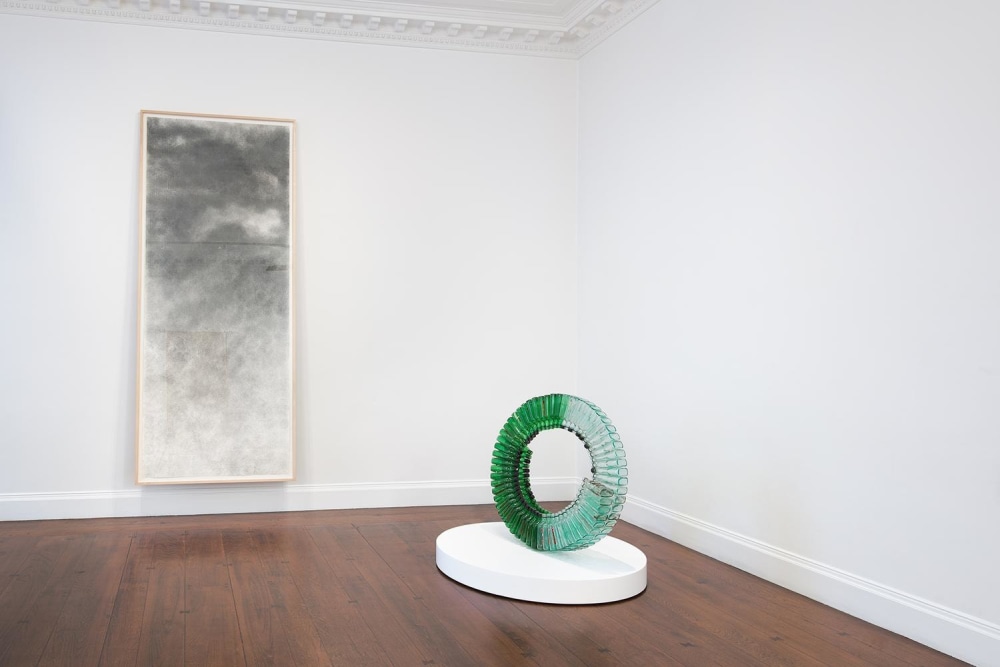
By Alexandra Fowle
David Hammons is still an anomaly with a gift for turning social absurdities into witticism. Though he has abandoned the perverse (more on this to follow), I wondered what his retrospective, Five Decades—with its blatant ridicule of cultural stereotypes, capitalism, class-resource disparity, and art-world peculiarities—was doing at Mnuchin Gallery in the Upper East Side, a neighborhood that is around eighty percent white and statistically holds more Republicans than most places in Manhattan. Then again, he’s spent his five-decade career sarcastically taunting us with our own predictability.
Hammons first rattled the art world in the 1960s during the height of the controversial Black Arts Movement (BAM), then again by famously (or infamously) pissing on a Richard Serra sculpture, and then again by refusing gallery representation. Today, a survey of the artist’s career confiscates the entirety of Mnuchin’s neoclassical, townhouse-style space. Asian music of undulating tempos ripples and trembles as the show’s backdrop score, where Hammons’s personal photographs are littered around mixed-media works of a broad spectrum. Relieved of the stiffening silences and fluorescent lights of white-box galleries, I moved slightly with the beat.
A lingering affable tenor persists in Hammons’s constructs of satire, puns, and one-liners, ranging from the pensive, to the academic, to the excruciatingly literal. Among the literal is Untitled (Freudian Slip) (1995), a photograph of a beady-eyed alien who’s maneuvered itself up the hem of a sheer pink lingerie slip. Though comparable deadpan works deliver respite from melancholy, they pale before the dominating politically hefty ones, like Untitled (Free Nelson Mandela) (1987), a photograph of Hammons’s Free Nelson Mandela (1987) sculpture that reflects his more brazen art-activism.
Hammons synthesizes object and language, flaunting his humor and politics, sometimes even toying with the contra for a laugh at nefarious sarcasm. Three microphones of herculean proportion, Which Mike do you want to be like…? (2001)—Mike Tyson, Michael Jordan, or Michael Jackson—seems jovial until it resonates as a jab at cyclical poverty and its narrowed escape paths. Likewise, Orange Is The New Black (2014), a rustic orange-painted Nkondi sculpture depicting two dogs nailed together, recalls Piper Kerman’s Netflix series—a humorous, theatrical facsimile of her time in a women’s “minimum security” prison—before the sobering, grim signifiers of America’s orange jumpsuits register. But Hammons persists beyond this slap at the germinating criminal justice system with the added critique, which surfaces from the Congolese Nkondi sculpture’s cultural weight as a symbol of human-to-human vice. Viewing Hammons’s work is never a quick, linear experience; it is more like an archeological dig for the jokes, the homages, and the messages.
Also scattered around Mnuchin’s rooms are unironic criticisms of capitalism and highbrow academia, which seem more palatable for many Upper-East Siders. A prime example of the artist’s satirical parodies on free enterprise is Untitled (Snowball) (1983/2003)—a snow-globe shape with a whitish-gray opaque “snowball” secured atop its wooden base—that recalls the time when Hammons sold actual snowballs on the Bowery as part of his performance piece Bliz-aard Ball Sale (1983). Yet Untitled (Snowball) ripens with the framed e-mail exchange between a collector and a dealer, which hangs adjacently: “As much as we would love to own a snowball, not a single insurance company would cover it for us [. . .] And since we are not made of money like SOME people [. . .] we will have to pass.” Evoking art-market capitalism and the commodification of basic resources, classist politics become warped through innuendo.
Moreover, in a recognizable mockery of art criticism, Untitled (Tribal Art) (2007) pictures a 1997 issue of Artforum, which the artist has trophied within a vitrine. This particular Artforum features Ai Weiwei and Marcel Broodthaers; yet with conviction to institutional critique, Hammons has blasted across the cover, “TRIBAL ART,” in thick, red font, above where the original cover reads, “ARE YOU CONFUSED?” He is one of the few artists to fracture the intellectual barriers prescribed by elitist jargon through his exposure of the hyper-intellectual language that preserves the art-world’s exclusive terrain. Only a handful of artists have so deliberately challenged those who hold market leverage, notwithstanding the historic scope of “political” artists and their propaganda work surrounding feminism, war, civil rights, among much more.
Within Hammons’s broad body of work, Five Decades is a collective reminder that “life is a cosmic joke and humankind is incorrigible.”1 The show alleges that art, class, race, education, and the entirety of American society is politicized, a notion of particular substance as we recognize that the civic weight of Hammons’s motifs have synonymously prevailed since the ’60s. But inklings of optimism nest within the disassociation between Hammons’s work and Mnuchin Gallery; if artist and gallery can collectively revise orthodoxies, perhaps there is prospect for demolishing the cultural, educational, and class-structure barriers that have disenfranchised many groups of individuals from the arts.
Hammons has visited Mnuchin unannounced on a handful of occasions to make changes to Five Decades and its configurations—adding, removing, and shuffling works, even eliminating text labels for ones written directly on the white walls. A head-shaped rock, Untitled (2004), topped with afro-textured hair, was substituted for a head-shaped rock of a different fade called Untitled (One Stone Head) (1997). About three weeks before closing, Hammons pragmatically swapped Untitled (Snowball) for a glass of water (e-mail remaining). New photographs were added while some were awkwardly moved to look like they’d fallen off the wall. The space seemed to progressively empty, as if we were witnessing capacious dilapidation over a small two-month window. Most importantly, Hammons has personalized our experiences of the show: those who only visited once are oblivious; those who saw it more than once strain to harmonize its changes with one’s own memory; and art critics scramble to revise “facts” that are no longer factual.